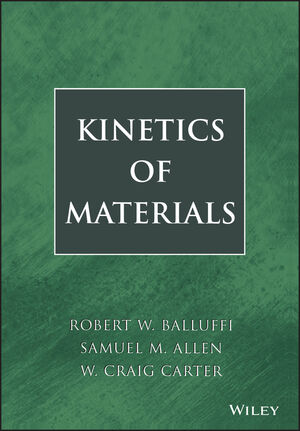|
Textbook
Kinetics of MaterialsISBN: 978-0-471-24689-3
Hardcover
672 pages
December 2005, ©2005
 This is a Print-on-Demand title. It will be printed specifically to fill your order. Please allow an additional 15-20 days delivery time. The book is not returnable.
|
||||||
A classroom-tested textbook providing a fundamental understanding of basic kinetic processes in materials
This textbook, reflecting the hands-on teaching experience of its three authors, evolved from Massachusetts Institute of Technology's first-year graduate curriculum in the Department of Materials Science and Engineering. It discusses key topics collectively representing the basic kinetic processes that cause changes in the size, shape, composition, and atomistic structure of materials. Readers gain a deeper understanding of these kinetic processes and of the properties and applications of materials.
Topics are introduced in a logical order, enabling students to develop a solid foundation before advancing to more sophisticated topics. Kinetics of Materials begins with diffusion, offering a description of the elementary manner in which atoms and molecules move around in solids and liquids. Next, the more complex motion of dislocations and interfaces is addressed. Finally, still more complex kinetic phenomena, such as morphological evolution and phase transformations, are treated.
Throughout the textbook, readers are instilled with an appreciation of the subject's analytic foundations and, in many cases, the approximations commonly used in the field. The authors offer many extensive derivations of important results to help illuminate their origins. While the principal focus is on kinetic phenomena in crystalline materials, select phenomena in noncrystalline materials are also discussed. In many cases, the principles involved apply to all materials.
Exercises with accompanying solutions are provided throughout Kinetics of Materials, enabling readers to put their newfound knowledge into practice. In addition, bibliographies are offered with each chapter, helping readers to investigate specialized topics in greater detail. Several appendices presenting important background material are also included.
With its unique range of topics, progressive structure, and extensive exercises, this classroom-tested textbook provides an enriching learning experience for first-year graduate students.
This textbook, reflecting the hands-on teaching experience of its three authors, evolved from Massachusetts Institute of Technology's first-year graduate curriculum in the Department of Materials Science and Engineering. It discusses key topics collectively representing the basic kinetic processes that cause changes in the size, shape, composition, and atomistic structure of materials. Readers gain a deeper understanding of these kinetic processes and of the properties and applications of materials.
Topics are introduced in a logical order, enabling students to develop a solid foundation before advancing to more sophisticated topics. Kinetics of Materials begins with diffusion, offering a description of the elementary manner in which atoms and molecules move around in solids and liquids. Next, the more complex motion of dislocations and interfaces is addressed. Finally, still more complex kinetic phenomena, such as morphological evolution and phase transformations, are treated.
Throughout the textbook, readers are instilled with an appreciation of the subject's analytic foundations and, in many cases, the approximations commonly used in the field. The authors offer many extensive derivations of important results to help illuminate their origins. While the principal focus is on kinetic phenomena in crystalline materials, select phenomena in noncrystalline materials are also discussed. In many cases, the principles involved apply to all materials.
Exercises with accompanying solutions are provided throughout Kinetics of Materials, enabling readers to put their newfound knowledge into practice. In addition, bibliographies are offered with each chapter, helping readers to investigate specialized topics in greater detail. Several appendices presenting important background material are also included.
With its unique range of topics, progressive structure, and extensive exercises, this classroom-tested textbook provides an enriching learning experience for first-year graduate students.



